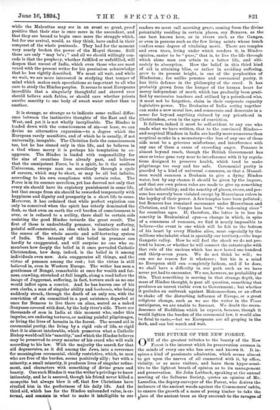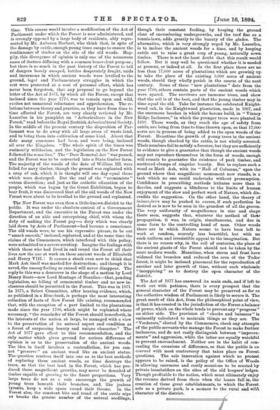THE FUTURE OF THE NEW FOREST.
ONE of the greatest tributes to the beauty of the New Forest is the interest which its preservation arouses in the minds of every one who has seen and known it. It in- spires a kind of passionate admiration, which seems almost to get upon the nerves of all connected with it, by office, vicinity, or as mere visitor?, and leave them hyper-sensi- tive to the lightest breath of opinion as to its management and preservation. Sir John Lubbock, speaking at the annual meeting of the Selborne Society, quotes an opinion of Mr. Lascelles, the deputy-surveyor of the Forest, who desires the inclosure of the ancient woods against the Commoners' cattle, to ensure the growth of a mass of young timber to take the lace of the ancient trees as they succumb to the ravages of
time. This course would involve a modification of the Act of Parliament under which the Forest is now administered, and is strongly opposed by a large body of residents, ably repre- sented by Mr. Auberon Herbert, who think that, in spite of the damage by cattle, enough young trees escape to ensure the continuance of timber on the site of the old woods. Hap- pily, this divergence of opinion is only one of the numerous cases of doctors differing with a common benevolent purpose; but there is so much in the past history of the Forest to tell of dangers barely escaped, battles desperately fought, raids and incursions in which ancient woods were levelled to the ground, legal and Parliamentary struggles in which the rest were protected at a cost of personal effort, which has never been forgotten, that any proposal to go beyond the letter of the Act of 1877, by which all the Forest, except that inclosed since the year 1770, was to remain open and wild, excites not unnatural reluctance and apprehension. The re- lations between theory and practice, as they have from time to time affected the Forest, are very clearly reviewed by Mr. Lascelles in his pamphlet on "Arboriculture in the New Forest," read before the Royal Scottish Arboricultural Society. In the middle of the present century the disposition of Par- liament was to do away with all large areas of waste land, and to bring them into cultivation of some kind. About that date many commons had been, and were being, inclosed all over the Kingdom. "The whole spirit of the times was eminently utilitarian, and the legislation on the New Forest followed the same line." The "Deer Removal Act "was passed, and the Forest was to be converted into a State timber farm. The majority of the woods of the date of William III. were felled for navy timber, though the ground was replanted with a crop of oak, which it is thought will one day equal those which were destroyed. But the zeal of the " economists " outran discretion; and just as the aasthetie education of the people, which was begun by the Great Exhibition, began to bear fruit, it was discovered that all the old woods of the New Forest were about to be levelled to the ground and replanted.
The New Forest was even then a little-known district to the public. It was under the absolute control of a Government Department, and the executive in the Forest was under the direction of an able and enterprising chief, with whom the duty of making the Forest pay—a duty which was clearly laid down by Acts of Parliament—had become a conscience. The old woods were, to use his expressive phrase, to be cut "smack smooth," inclosed, replanted, and at the same time the claims of the Commoners, which interfered with this policy, were submitted to a severe scrutiny. Imagine the feelings with which those who had lived in and round the Forest all their lives saw the axe at work on these ancient woods of Elizabeth and Henry VIII.! It causes a shock even now to think that Mark Ash itself was marked for destruction; and though it is saved, the uneasy feeling so caused will never disappear. The reply to this was a demurrer in the shape of a motion by Lord Henry Scott—now Lord Montagu of Beaulieu—that, pending legislation, no felling of ornamental timber and no new in- closures should be permitted in the Forest. This was in 1871. In 1875, a Select Committee, after hearing evidence, which, as published in a Blue-book, is perhaps the most interesting collection of facts of New Forest life existing, recommended that, with the exception of a part limited to the plantations made since the year 1700, which might be replanted where necessary, "the remainder of the Forest should henceforth, in the interests of the nation at large, be managed with a view to the preservation of its natural aspect and condition as a forest of surpassing beauty and unique character." The Act of 1877 gave effect to this recommendation, and the only matter which gives ground for serious difference of opinion is as to the preservation of the ancient woods. The idea in itself involves a contradiction, for you can- not " preserve " an ancient wood like an ancient statue. The question resolves itself into one as to the best methods of replacing these ancient woods, as time destroys the trees, so that the best land in the Forest, which has pro- duced these magnificent growths, may never be denuded of timber capable of growing to the finest proportions. Very large trees do not as a rule encourage the growth of young trees beneath their branches, and, like jealous tyrants, keep a wide space round their throne. In the Forest also, the constant bite and tread of the cattle nips or breaks the greater number of the natural seedlings,
though their constant feeding, by keeping the ground clear of encumbering undergrowths, and the turf fine as a tennis-lawn, adds greatly to the beauty of the glades. The alternative, which is very strongly urged by Mr. Lascelles, is to inclose the ancient woods for a time, and by keeping cattle out to raise a great crop of young, naturally sown timber. There is not the least doubt that this result would follow. But it may well be questioned whether it is needed at present, or indeed at all. In the first place there are no less than 17,000 acres of plantations which are growink up. to take the place of the existing 5,000 acres of ancient woods, should they wholly perish in the course of the next century. Some of these "new plantations" date from the year 1700, others contain parts of the ancient woods which were spared. The survivors are immense trees, and show that the soil is of the best, and that the young timber may in, time equal the old. Take for instance the celebrated Knight- wood oak, in the Knightwood plantation, made in 1867, and the enormous beeches in which the herons build, in " Yinney Ridge Inclosure," in which the younger trees were planted in 1859. These woods, as they reach the age of safety from cattle, are being from time to time thrown open, so that 17,000k acres are in process of being added to the open woods of the Forest. Meantime the growth of young trees in the ancient woods, though checked by the cattle, is not wholly arrested. Their numbers fail to satisfy a forester, but they are sufficiently, in evidence to give a guarantee that though the ancient woods may not reproduce themselves in the form of woods, enough will remain to guarantee the existence of park timber, and, scattered clumps of singular beauty. But to replace such a wood as Mark Ash, with its "Hall of Columns," upon the ground where that magnificent monument now stands, is a task which no one could undertake without presumption. Confidence in prescribing methods irritates more than it dazzles, and suggests a blindness to the limits of human enjoyment of the slow and perfect work of Nature, which dis- credits the suggestion. On the other hand, the theory of laissez-faire may be pushed to excess, if such perfection be desired as is now to be seen in the grandest of all the groves. The very uniformity of magnificence in size and shape there seen, suggests that, whatever the method of their- propagation, it was, in origin, simultaneous, and due in some form to the controlling hand of man. Other woods there are in which Nature seems to have been left to. work at random, scarcely less beautiful, but with no- such uniform and irresistible appeal to the imagination. But there is no reason why, in the roll of centuries, the plane of the ancient giants of the Forest should not be taken by the- more modern woods. Meantime, when storm and frost have- widened the breaches and reduced the area of the Tudor forest, it might be inclosed piecemeal for the reproduction of another and later growth of time, without such wholesale- " incoppicing " as to destroy the open character of the- district.
The Act of 1877 has answered its main ends, and if left to work out with patience, there is every prospect that the general character of the Forest may be preserved as far as- the collective wisdom of Parliament is likely to secure it. The great merit of this Act, from the philosophical point of view, is that it has created in the jurisdiction of the Forest a balance- of power, which on the whole tends to prevent any " progress " on either side. The provision of "checks and balances" is eminently calculated to maintain things as they are. The "Verderers," elected by the Commoners, check any attempts of the public servants who manage the Forest to make further inclosures, and do not easily distinguish between " improve- ments" and aggression, while the latter are equally watchful to prevent encroachment. Neither are in the habit of con- cealing the occasions of difference, so that the public is as courant with most controversy that takes place on Forest questions. The sole innovation against which no protest, appears to be raised, is the policy of the Office of Woods. in allowing enormous and costly mansions to be erected by private leaseholders on the sites of the old keepers' lodges. Though profitable to the nation, which must ultimately enjoy the revenue derived from them when the leases fall in, the creation of these great establishments, to which the Forest acts as a private park, is a menace to the rural and wild character of the district.



































 Previous page
Previous page